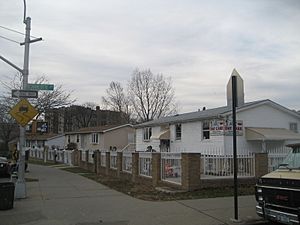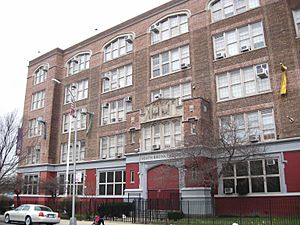South Bronx facts for kids
The South Bronx is a special part of the New York City area called the Bronx. It includes neighborhoods like Concourse, Mott Haven, Melrose, and Port Morris.
Long ago, in the early 1900s, this area was known as the Manor of Morrisania. It was owned by the Morris family. Over time, many German and Irish immigrants moved here. By the 1930s, a large part of the Bronx population was Jewish. But after World War II, rents went up, and many people moved out. By the late 1950s, most residents in the South Bronx were African American or Hispanic.
The South Bronx is famous for its hip hop culture and graffiti art. Graffiti became popular in the early 1970s, spreading through the New York City Subway system. The South Bronx is also known as the birthplace of hip-hop music and culture in 1974.
In 2010, the U.S. Census showed that the South Bronx was one of the less wealthy areas in the United States. About half of its residents live with less money.
Contents
What is the South Bronx?
The exact borders of the South Bronx have changed over time. They are still debated by some. But it definitely includes the neighborhoods of Mott Haven, Melrose, and Port Morris. Sometimes, other areas like Belmont, Castle Hill, Hunts Point, and Soundview are also considered part of the South Bronx.
The NYPD helps keep these neighborhoods safe.
A Look Back in Time
The South Bronx was first called the Manor of Morrisania. It was owned by the powerful Morris family. Famous members included Lewis Morris, who signed the United States Declaration of Independence, and Gouverneur Morris, who helped write the Constitution of the United States. Their family church, St. Ann's Church, is still there.
As the Morris family developed their land, many German and Irish immigrants moved in. Later, the Bronx became known as the "Jewish Borough." In 1930, almost half of its people were Jewish.
Changes in the 1950s
After World War II, many white families moved out of the city. More African American and Puerto Rican families moved into the South Bronx. In 1950, two-thirds of the people were non-Hispanic white. By 1960, two-thirds were black or Puerto Rican. The area known as the South Bronx also grew to include places like Hunts Point and Highbridge.
Challenges in the 1960s
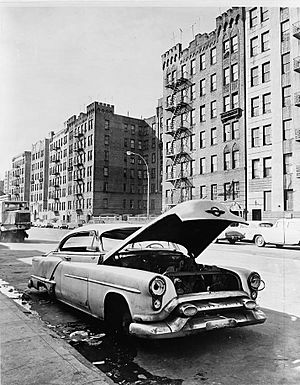
The South Bronx was a place for working-class families. But in the late 20th century, it faced many problems. These included families moving away, landlords abandoning buildings, and changes in the economy. The building of the Cross Bronx Expressway also played a big part.
The Cross Bronx Expressway was finished in 1963. It was part of a city project by Robert Moses. This highway cut right through the South Bronx. It forced thousands of people and businesses to move. Many believe it caused a lot of damage to the area in the 1970s and 1980s. For example, the neighborhood of East Tremont was almost completely destroyed by the highway.
The value of properties went down, and many apartments became empty. Tensions from the Civil Rights Movement in the 1950s and 1960s also made middle-class families move away. Some parents moved to the suburbs because they worried about their children attending schools with new racial balance policies.
By the late 1960s, the South Bronx had the most empty homes in the city.
The 1970s: "The Bronx is Burning"
In the 1970s, the South Bronx faced serious challenges. About 300,000 residents left, and entire city blocks of buildings were destroyed. The news often showed the problems in the South Bronx.
The famous phrase "The Bronx is burning" came from a baseball game in 1977. During a New York Yankees game, a helicopter shot showed a fire burning in the South Bronx near Yankee Stadium. This phrase became a symbol of the many fires and economic problems in the area during that time.
Rebuilding and Today
Starting in the late 1980s, the South Bronx began to rebuild. New homes and apartment buildings were constructed. Over a billion US dollars were spent on rebuilding through the 1990s. More than 19,000 apartments were fixed up, and over 4,500 new houses were built. More than 26,500 people moved into the area. Charlotte Street, once devastated, now has nice homes.
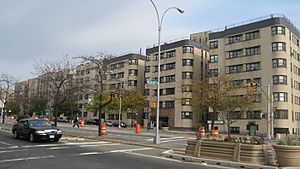
The Bronx County Courthouse is now a protected landmark. Efforts are being made to protect the Grand Concourse because of its beautiful Art Deco buildings.
A new Yankee Stadium was built. It also brought new sports fields, tennis courts, and a new train station. This station helps ease crowding on the subway during baseball season.
The population of the South Bronx is growing again. However, about one out of two residents still lives in poverty. The area is working to improve safety and reduce crime rates.
Arts and Culture
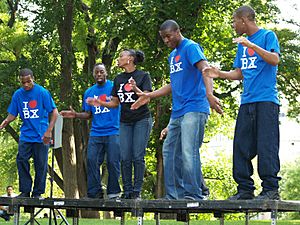
Since the late 1970s, the South Bronx has had a lively art scene. Galleries like Fashion Moda helped launch artists such as Keith Haring. The Bronx Academy of Arts and Dance is also located here.
Modern graffiti is very important in the South Bronx. Many famous graffiti artists, like Tats Cru, come from here. Graffiti started in the Bronx in the early 1970s and spread through the New York City Subway system.
The rise of hip-hop music, rap, breakdancing, and disc jockeying put the South Bronx on the music map in the late 1970s. The South Bronx is known worldwide as the birthplace of hip-hop culture. The Bronx Museum of the Arts is also on the Grand Concourse.
Hip Hop's Birthplace
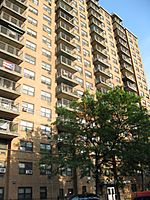
Hip hop is a group of art forms that started as a street culture in the South Bronx in the 1970s. Hip hop music and culture began when block parties became popular in New York City. These parties were especially popular among African American and Latin American people in the Bronx.
At these parties, DJs played popular music like funk and soul music. They would often play songs by artists like James Brown. DJs started to focus on the "percussive breaks" of songs. These are parts of a song, often without singing, that are easy to dance to.
DJ Kool Herc is famous for a technique called "merry-go-rounding." This is when DJs use two turntables to switch back and forth between two copies of the same record. This allowed them to extend the danceable parts of the music. This technique came from Jamaican dub music. DJ Kool Herc, who came from Jamaica, brought it to New York. He is often called the father of hip-hop.
DJ Kool Herc also introduced "Jamaican toasting." This is speaking over a beat, which later became known as rapping.
1520 Sedgwick Avenue, an apartment building in Morris Heights, is known as a very important place for hip hop. In 2010, The New York Times called it the "accepted birthplace of hip hop." DJ Kool Herc held parties in the community room there. He is credited with helping to start hip hop and rap music at a party on August 11, 1973. While hip hop grew in many places, 1520 Sedgwick Avenue was a key spot where it truly took off. DJ Kool Herc once said, "1520 Sedgwick is the Bethlehem of Hip-Hop culture."
In the early 1970s, many people in the South Bronx lived in poverty or were part of gangs. Afrika Bambaataa, a former gang member, became known as the "godfather of hip-hop." He created the Zulu Nation. This group focused on "Peace, Love, Unity, Having Fun" instead of gang violence. Hip hop helped reduce street violence and eased tensions with the police. People were creating art and music at block parties, which police did not have issues with.
Besides music, B-boying (breakdancing) also started in the South Bronx. When DJs played the break beats, people started to dance in new ways. This "spontaneous" dancing included "bouncing around, pivoting, turning, twists, and frontsweeps." Many breakdancers were part of crews, like the Rock Steady Crew.
On July 5, 2007, 1520 Sedgwick Avenue was officially recognized as the "Birthplace of Hip-Hop" by New York State.
Education and Learning
The New York City Department of Education runs public schools in the South Bronx. There are also charter schools, like Success Academies Bronx. Private schools include Cardinal Hayes High School and All Hallows High School.
For higher education, Hostos Community College is located in the South Bronx.
Many organizations in the South Bronx offer training and educational programs. East Side House Settlement helps families and children through education. Per Scholas offers free training for computer certifications, helping people get jobs in technology. They also help middle school students and their families with computer training.
Getting Around the South Bronx
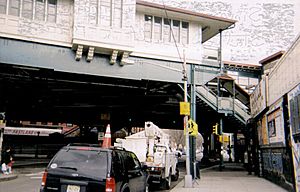
Major highways in the South Bronx include the Major Deegan Expressway (I-87) and the Cross Bronx Expressway (I-95). The Grand Concourse is also a main road.
Many New York City Subway lines run through the South Bronx. These include the 6 <6> trains, 2 5 trains, 4 train, and B D trains lines.
A special pathway called the South Bronx Greenway connects the South Bronx to Randalls Island for bikes and walkers.
In 2000, most households in the South Bronx (77.3%) did not own cars. This is much higher than the city average.
Famous People from the South Bronx
- Danny Aiello (1933–2019), actor
- Nate Archibald (born 1948), basketball player
- Aventura, music group
- Afrika Bambaataa (born 1957), DJ and producer
- Swizz Beatz (born 1978), rapper and producer
- Cardi B, rapper, raised in Highbridge, Bronx
- Willie Colón, salsa musician
- Bobby Darin, singer and actor
- Dion DiMucci & the Belmonts, musicians
- Fat Joe, rapper, raised in Morrisania
- Grandmaster Flash, DJ, raised in Morrisania
- Jennifer Lopez, raised in Castle Hill
- DJ Kool Herc, DJ, raised in the West Bronx
- Colin Powell, raised in Longwood
- Sonia Sotomayor (born 1954), Supreme Court Justice
- Neil deGrasse Tyson, astrophysicist
- Kemba Walker, NBA player, raised in Soundview
- Kerry Washington, actress
The South Bronx in Pop Culture
The South Bronx has been featured in many movies, songs, and TV shows.
Movies include:
- Rumble in the Bronx (1995)
- Fort Apache, The Bronx (1981)
- Wild Style (1983)
- Beat Street (1984)
Music includes:
- "South Bronx (song)" by Boogie Down Productions
- "Jenny from the Block" by Jennifer Lopez
Television includes:
- The Get Down (2016), a Netflix series about the birth of hip hop.
Literature includes:
- Dropsie Avenue (1995) by Will Eisner, a graphic novel set in a fictional South Bronx neighborhood.
See also
 In Spanish: South Bronx para niños
In Spanish: South Bronx para niños





